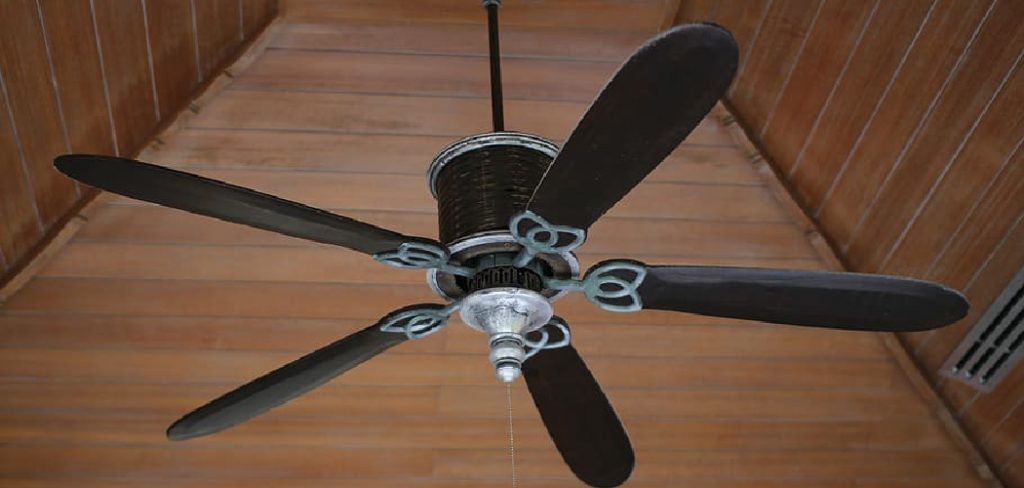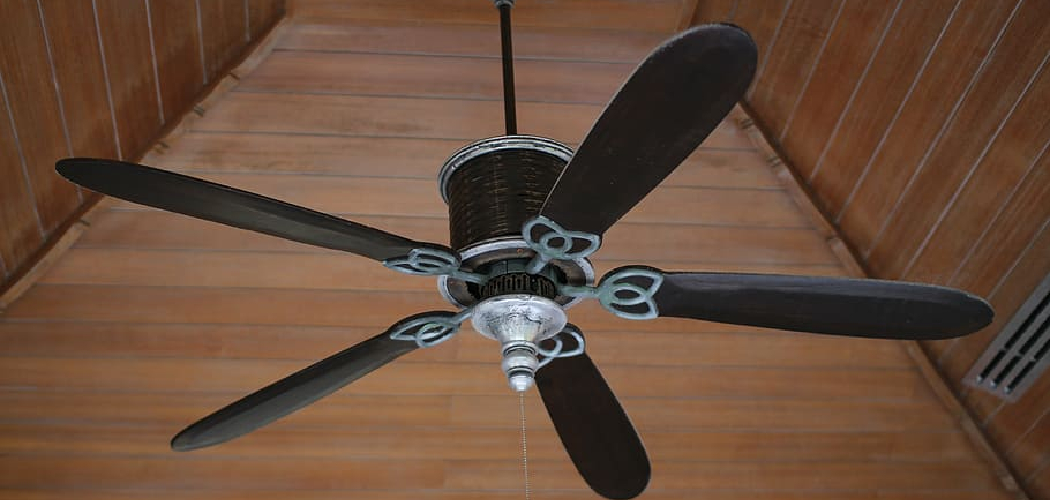Are you wondering if that ceiling fan is an AC or DC model? You’ve come to the right place! Knowing the difference between AC and DC fans can help you get better performance, value for money, and safety when it comes to your ceiling fan.

In this blog post, we will explore how to tell if ceiling fan is AC or DC. We’ll discuss some important factors like electricity consumption, speed control options, blade pitch angle settings and more so you know exactly what kind of fan best suits your needs. Read on to learn important tips about determining whether a particular model belongs in the AC or DC category!
9 Best Methods on How to Tell if Ceiling Fan is Ac or Dc
1. Look at the Motor:
The motor is the heart of your ceiling fan, and it can tell you a lot about whether it’s an AC or DC model. In general, AC motors are larger and bulkier compared to DC motors. They also have more visible wire connections on the side, while DC motors have fewer wires and a sleeker design. If you see a large motor with visible wiring, then the fan is most likely an AC model. But if you see a compact, streamlined motor with fewer wires, it’s probably DC.
2. Check the Voltage Rating:
Another way to tell if your ceiling fan is AC or DC is by checking its voltage rating. AC fans usually have a voltage rating of 110V or 220V, while DC fans have a voltage rating of 12V or 24V. You can find this information on the fan’s packaging or specifications sheet. Checking the voltage rating can help you determine if the fan is AC or DC, and also ensure that it’s compatible with your home electrical system.
3. Look at the Speed Control Options:
AC fans typically have a limited number of speed control options, usually three or four settings. On the other hand, DC fans come with a wide range of speed control options, including variable speeds and even reverse direction settings. This is because DC motors allow for more precise speed control and have a wider range of speed capabilities. If your fan offers multiple speed options or the ability to change direction, it’s likely a DC model.
4. Examine the Blade Pitch Angle Settings:

The blade pitch angle refers to the angle at which the blades are tilted. AC fans typically have a fixed blade pitch angle, whereas DC fans allow for adjustable blade angles. This is because DC motors can be controlled to provide varying amounts of torque, which affects the fan’s airflow. If you notice that your fan has an option to change the blade pitch angle, it’s most likely a DC model.
5. Test the Noise Level:
One key advantage of DC fans is that they operate more quietly compared to AC fans. This is because DC motors are designed with brushless technology, which reduces friction and noise. To tell if your fan is an AC or DC model based on noise level, simply turn it on and listen closely. If you can hear a noticeable humming sound, it’s probably an AC fan. But if you can barely hear anything, it’s most likely a DC model.
6. Check the Energy Consumption:
DC fans are known for their energy efficiency, thanks to their use of brushless DC motors and variable speed control options. In comparison, AC fans tend to consume more electricity due to their fixed-speed design. To determine if your fan is AC or DC based on energy consumption, check the wattage rating. A lower wattage indicates a DC fan, while a higher wattage is typically associated with AC fans.
7. Look at the Type of Power Supply:
AC fans usually plug directly into an electrical outlet using a standard power cord. On the other hand, DC fans often come with external power supplies that convert AC power to DC power. If your fan has a separate power supply, it’s most likely a DC model. However, some newer models of DC fans may come with an integrated power supply that plugs directly into the outlet.
8. Read the Label:

When in doubt, read the label! Most ceiling fan manufacturers will clearly indicate on the packaging or label whether the fan is an AC or DC model. Make sure to check for this information before purchasing a fan to ensure that it meets your desired specifications. You can also find additional information about the fan’s features and specifications on the label.
9. Consult with an Expert:
If you still can’t determine whether your ceiling fan is AC or DC after trying these methods, it’s best to consult with an expert. An electrician or ceiling fan specialist will be able to easily identify the type of fan by examining its components and specifications. They can also provide valuable insights on which type of fan is best suited for your specific needs.
Following these methods, you can easily tell if your ceiling fan is an AC or DC model. Knowing the difference between these two types of fans can help you make a more informed decision when purchasing a new fan or troubleshooting any issues with your current one.
We hope this blog post has been helpful in answering your questions about identifying AC and DC ceiling fans! Remember to always prioritize safety and proper installation when dealing with electrical appliances. Stay cool!
Additional Tips and Tricks to Tell if a Ceiling Fan is Ac or Dc
- One simple way to determine if your ceiling fan is AC or DC is by checking the voltage. AC fans typically operate at 120 volts, while DC fans usually run at 12 or 24 volts.
- Another method is to look for a mark on the motor of your ceiling fan. AC motors are usually marked with ‘AC’, while DC motors are marked with ‘DC’.
- You can also try spinning the fan blades by hand. If the blades continue to spin for a while after you stop, then it is most likely an AC fan. But if they quickly come to a halt, then it is probably a DC fan.
- Some modern ceiling fans have built-in LED lights that only operate with DC power, so if your ceiling fan has this feature, it is most likely a DC fan.
- AC fans usually have a pull chain or wall control switch to change the speed settings, while DC fans often have a remote control for speed and light settings.
- If all else fails, consult the user manual or contact the manufacturer for more information on your specific ceiling fan model. They can provide you with accurate information on whether your fan is AC or DC.
- Keep in mind that there are also fans that have dual functionality, which means they can operate using either AC or DC power sources. In this case, it may be best to consult a professional electrician for assistance.
- Lastly, always prioritize safety when handling any electrical equipment. If you are unsure about the type of ceiling fan you have, it is always best to seek professional help rather than risk potential hazards. So, be cautious and stay safe!
Following these tips and tricks should give you a better understanding of the type of ceiling fan you have. By knowing if your fan is AC or DC, you can make informed decisions on maintenance and repairs, as well as choose the right replacement parts if needed. We hope this information has been helpful in your quest to determine the type of ceiling fan you have! Remember to always prioritize safety and consult experts when in doubt. Happy ceiling fan troubleshooting!
Frequently Asked Questions
What Are AC and DC?
AC stands for Alternating Current, while DC stands for Direct Current. These two terms describe the electronic signal that powers most of our household appliances. AC is a type of current that changes direction periodically, while DC flows in one direction.
How Do I Know if My Ceiling Fan Uses AC or DC?

The simplest way to determine whether your ceiling fan uses AC or DC is by looking at the power source. If your fan plugs into an electrical outlet, then it uses AC. On the other hand, if your fan is hardwired into your home’s electrical system, then it uses DC.
Which One is Better for Ceiling Fans?
The answer to this question depends on personal preferences and needs. Both AC and DC can effectively power a ceiling fan. However, some people may prefer one over the other due to factors such as energy efficiency, cost, and maintenance. For example, DC fans are generally more energy-efficient and quieter than AC fans. On the other hand, AC fans tend to be cheaper and have a longer lifespan.
Conclusion
Now you know how to tell if ceiling fan is AC or DC. Understanding the difference between AC and DC can help you make a more informed decision when purchasing a ceiling fan. Remember to always consider your personal needs and preferences when choosing between AC or DC-powered fans. So whether it’s an AC or DC-powered ceiling fan, sit back, relax, and enjoy the cool breeze!
